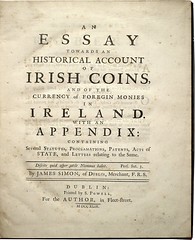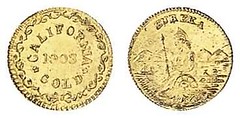
About UsThe Numismatic Bibliomania Society is a non-profit organization promoting numismatic literature. For more information please see our web site at coinbooks.org SubscriptionsThose wishing to become new E-Sylum subscribers (or wishing to Unsubscribe) can go to the following web page link MembershipThere is a membership application available on the web site Membership Application To join, print the application and return it with your check to the address printed on the application. Membership is only $15 to addresses in the U.S., $20 for First Class mail, and $25 elsewhere. For those without web access, write to: David M. Sundman, Secretary/TreasurerNumismatic Bibliomania
Society AsylumFor Asylum mailing address changes and other membership questions, contact David at this email address: dsundman@LittletonCoin.com SubmissionsTo submit items for publication in The E-Sylum, just Reply to this message, or write to the Editor at this address: whomren@coinlibrary.com
BUY THE BOOK BEFORE THE COINYou won't regret it! |
- WAYNE'S WORDS: THE E-SYLUM JANUARY 30, 2011
- THE AOL SAGA CONTINUES
- SKLOW MAIL BID SALE NO. 12 CLOSES FEBRUARY 12, 2011
- BALDWIN'S OFFERS NUMISMATIC LITERATURE ON WINTER FIXED PRICE LIST
- NEW BOOK: 100 GREATEST U.S. MODERN COINS
- NEW BOOK: MONEYMAKERS: ADVENTURES OF THREE NOTORIOUS COUNTERFEITERS
- BOOK REVIEW: SILVER DOLLARS STRUCK UNDER THE PITTMAN ACT OF 1918
- BOOK REVIEW: THE TRUE HARD TIMES TOKENS BY ROBERT SCHUMAN
- BOOK REVIEW: A GUIDE BOOK OF UNITED STATES PAPER MONEY, 3RD EDITION
- WILLIAM L. BISCHOFF 1938 - 2010
- ALAN STAHL RECEIVES ROYAL NUMISMATIC SOCIETY MEDAL
- AMERICAN NUMISMATIC SOCIETY ARCHIVES UPDATE
- NEW ORLEANS MINT RECORDS AT FORT WORTH NATIONAL ARCHIVES
- THE NATIONAL NUMISMATIC MUSEUM OF GREECE
- COULD MORE E-BOOKS REVITALIZE NUMISMATIC HOBBY?
- KEN BRESSETT ON ASTROLOGICAL SYMBOLS ON ANCIENT COINS
- PROPOSED NEW TERMS FOR A NUMISMATIC ENCYCLOPEDIA
- GUS ZIMMERMAN'S TARGET SHOOTING MEDALS
- NOTES FROM E-SYLUM READERS: JANUARY 30, 2011
- MARCEL DUCHAMP'S MONTE CARLO BOND NO 1
- HISTORIAN ACCUSED OF ALTERING LINCOLN DOCUMENT AT NATIONAL ARCHIVES
- 9/11 MUSEUM TO DISPLAY "HOLOCAUST COIN"
- LAWMAKERS ATTACK NATIONAL COLLECTOR'S MINT LATEST 9/11 "COINS"
- FEATURED WEB PAGE: COPPIN'S 1858 BALLOON MEDAL
WAYNE'S WORDS: THE E-SYLUM JANUARY 30, 2011

Among our new subscribers this week are Hannah Koenig and James Wolfe. Welcome aboard! We now have 1,397 email subscribers, plus 114 followers on Facebook, including Matt G. Djmatt Draiss and Rick Reynolds.
This week we open with a note for AOL subscribers, a reminder about David Sklow's upcoming literature sale, and a peek at some numismatic literature in Baldwin's latest fixed price list. Next up are announcements of two new numismatic books and reviews of three more.
To learn more about a new book on Hard Times Tokens, the national numismatic museum of Greece, coelanaglyptic relief, Gus Zimmerman's shooting medals, Marcel Duchamp's Monte Carlo bond, and Coppin's Balloon medal, read on. Have a great week, everyone!
Wayne Homren
Numismatic Bibliomania Society
THE AOL SAGA CONTINUES
Gerard Anaszewicz writes:
I use AOL. I keep getting errors that the email is not available.
Larry Sekulich writes:
I have not been able to open the E-Sylum. I get the following message..."There was an error loading the message. Please try again later."
More and more people are having problems getting their newsletter thru AOL. We're (still) looking into it. A new tech person is working on it, and claims he might know how to fix it. We'll see, but in the meantime, the only reliable way to get The E-Sylum is thru another email provider or reading it on the web. Sorry!
Another E-Sylum subscriber writes:
AOL has screwed me over for the last time. You'll get a mass notification of my new Gmail address tomorrow, when I'm sure that all of my contacts have transferred over, but I wanted to be sure to ask you directly to switch The E-Sylum over. It'll be great to get the big E in my mailbox again, without having to go the web archive.
To read the earlier E-Sylum article, see: AOL: ABANDON HOPE ALL YE WHO SUBSCRIBE HERE (www.coinbooks.org/esylum_v13n48a03.html)
SKLOW MAIL BID SALE NO. 12 CLOSES FEBRUARY 12, 2011
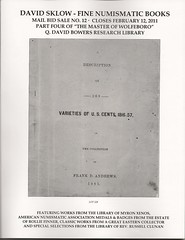 There is still time to get your bids in on a wide variety of numismatic treasures in our largest to date auction sale featuring part four of "The Master of Wolfeboro" Q. David Bowers research library.
There is still time to get your bids in on a wide variety of numismatic treasures in our largest to date auction sale featuring part four of "The Master of Wolfeboro" Q. David Bowers research library.
Bidders may enter bids by mail, telephone, email or fax. The sale closes at 8pm mountain time, February 12, 2011, however, any bids left on our answering machines or sent by email or fax on or before midnight on closing day will be accepted.
The catalog is viewable on our website. Individuals on our mailing list will have already received their catalogs. Catalogs are available upon request at no charge.
DAVID SKLOW – FINE NUMISMATIC BOOKS
P.O. BOX 6321
COLORADO SPRINGS, CO 80934
TEL: (719) 302-5686
FAX: (719) 302-4933
finenumismaticbooks@aol.com
www.finenumismaticbooks.com
BALDWIN'S OFFERS NUMISMATIC LITERATURE ON WINTER FIXED PRICE LIST
Baldwin's are delighted to announce that their new Fixed Price List is now available both in printed format and online at www.baldwin.co.uk. As in previous years the new list comprises a wide selection of Ancient, British and Scottish Coins, including an unusually large run of unduplicated Anglo-Saxon pennies and a small run of Celtic gold coins, as well as a good selection of numismatic books.
During the compilation of this list the Baldwin's specialist team discovered a new transitional die variety of the William IV Crown, unrecorded in English Silver Coinage. The proof crown of 1831 created by William Wyon would appear to be the first die proposed for the new William IV Crown. Wyon spelt his surname in full on the bust of the King's portrait, which must have been considered as far too bold, but rather than waste a valuable obverse die Wyon must have re-filled the signature on the die's truncation and re-engraved with an incuse WW over the top. This is an extremely interesting discovery for English coin enthusiasts and William Wyon aficionados alike.
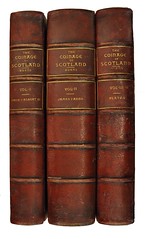
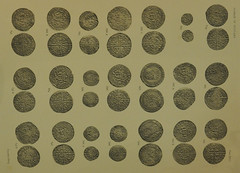
A smaller selection of numismatic books completes the list with a few notable items of great interest. Item NB011, a copy of Edward Burns ‘The Coinage of Scotland' is illustrated in part from the collections of Thomas Coats Esq. The three volumes were printed in Edinburgh in 1887 and are one of only 45 large paper copies ever produced. Other copies can be found in libraries and institutions internationally and so it is unusual for these volumes to be offered for sale on the open market. The books are priced at £875.
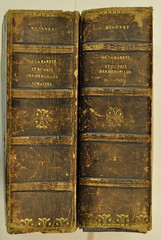
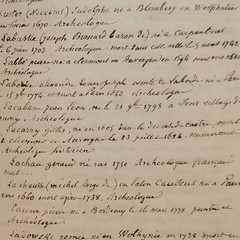
Item NB040, is perhaps one of the most interesting items in the list. A copy of both volumes of T.E. Mionnet's book De La Rareté Et Du Prix Des Médailles Romaines, have been interleaved and rebound with photographs and photocopies of illustrations taken from contemporary auction catalogues, cut and pasted onto the relevant pages. These images are accompanied throughout by numerous handwritten notes in French but sadly there are no clues as to the identity of the compiler . These unique volumes are priced at £365.
A. H. Baldwin & Sons Ltd were established 1872 and are one of the oldest numismatic dealers and auctioneers in the industry. Since our formation we have built the largest stock of coins in the UK and the Baldwin's specialist team scour three continents to source the rarest and highest quality items through attendance at international fairs and auctions. The bi-annual list produced by Baldwin's retail department is a product of all of our hard work and a compliment to the online stock listed at www.baldwin.co.uk and the extensive selection of coins held at the Baldwin's offices in London.
A NEWLY DISCOVERED TRANSITIONAL DIE VARIETY OF WILLIAM IV CROWN
BM052 William IV (1830-1837), Proof Crown, 1831, bare head right, W. W. engraved incuse over a weaker trace of a die-filled W. WYON on truncation, rev crowned mantle over quartered shield with escutcheon of the Arms of Hanover, within Order of the Garter, date below, plain edge (cf. ESC.271 / 278; L&S 1 / 3; cf. Davies 300; S.3833).
NEW BOOK: 100 GREATEST U.S. MODERN COINS
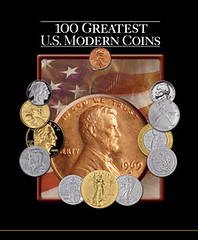 Whitman Publishing announces the release of 100 Greatest U.S. Modern Coins, by Scott Schechter and Jeff Garrett. In this beautifully illustrated book, two celebrated numismatists take the reader on a guided tour of the circulating, bullion, and commemorative issues so avidly sought by collectors today. The book will be available February 21, 2011, online (including at WhitmanBooks.com) and from booksellers and hobby shops nationwide.
Whitman Publishing announces the release of 100 Greatest U.S. Modern Coins, by Scott Schechter and Jeff Garrett. In this beautifully illustrated book, two celebrated numismatists take the reader on a guided tour of the circulating, bullion, and commemorative issues so avidly sought by collectors today. The book will be available February 21, 2011, online (including at WhitmanBooks.com) and from booksellers and hobby shops nationwide.
100 Greatest U.S. Modern Coins is the eighth entry in Whitman Publishing's 100 Greatest™ library. Preceding books showcase coins, paper money, medals and tokens, comic books, and stamps.
"The 100 Greatest were selected and ranked by the authors with input from leading coin dealers, researchers, and collectors, and a survey of current journals and periodicals," said Whitman publisher Dennis Tucker.
Inside the reader will find prized and seldom-seen rarities—the scarce and high-valued pieces that collectors dream about. Some are die varieties, like the 1969-S doubled-die obverse Lincoln cent and various "No S" Proof coins. Some are errors, like the famous 2000 Sacagawea dollar / Washington quarter mule. A few are coins that shouldn't exist, like the 1974 aluminum Lincoln cent and the mysterious 1964 Special Mint Set coinage. And many are coins with small mintages or poor distribution, or that saw low initial interest from collectors—factors that make them scarce and popular today.
The book also explores more readily available coins: pieces so beautiful or with such important and fascinating stories that everybody wants one. The 1999-S silver Proof Delaware quarter, the 1996-W Roosevelt dime, the 1983-P Washington quarter, the 1982 Washington commemorative half dollar, and dozens more are pictured in bold full color, with their stories told in engaging detail.

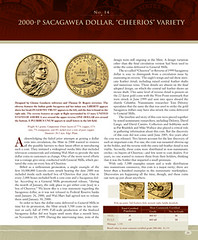
The book includes forewords by numismatic legends Kenneth Bressett and Q. David Bowers. An illustrated introduction answers the question, "What are modern coins?" (As a starting point, Schechter and Garrett discuss 1964 as a pivotal year for modern coinage.) The introduction also covers methods of modern coin manufacture and packaging; the differences between varieties and errors; how modern coins are graded; and how the 100 Greatest were chosen and ranked.
Throughout the book, Schechter and Garrett describe how to collect and enjoy U.S. modern coins, aspects of the marketplace, and smart buying.
Ken Bressett, longtime editor of the best-selling Guide Book of United States Coins, calls the book "compelling." In his foreword he wrote, "You will be not only fascinated by the coins, but also thrilled to know that some can actually be found in your pocket change. They disprove the axiom that all the good coins are gone from circulation."
Q. David Bowers, the "Dean of American Numismatics," in his foreword wrote about the hobby's growing passion for die varieties, the rebirth of the U.S. commemorative coin program, and other aspects of modern collecting. "I enjoyed reading about my own favorite coins," he said, "but also came to appreciate many I had overlooked."
Various Reverse Proof bullion pieces, the "Cheerios" Sacagawea dollar, the 2009 Ultra High Relief double eagle, Wisconsin's "Extra Leaf" state quarters, "Godless" Presidential dollars, Speared Bisons, and more await the reader of 100 Greatest U.S. Modern Coins.
The book is coffee-table-size, 128 pages, in full color, with photographs and stories for every coin. It also includes market values, field populations, certified-coin census reports, quantities minted, specifications, and design notes.
100 Greatest U.S. Modern Coins will be available February 21, 2011, online and from hobby shops and bookstores nationwide.
Authors: Scott Schechter and Jeff Garrett
Forewords by Kenneth Bressett and Q. David Bowers
ISBN 0794832563
Full color, illustrated, 128 pages.
10 x 12 inches.
Hardcover.
Retail $29.95
ABOUT THE AUTHORS
Scott Schechter is the son of a collector and has been involved in numismatics since childhood. In his early teens, he started traveling to numismatic conventions around the country and began collecting U.S. commemorative coins. This area of numismatics remains a core interest. While still in high school, he had his first formal job in numismatics as an intern at the Smithsonian's National Museum of American History, working with the National Numismatic Collection. Throughout college, he cataloged ancient coins at the Semitic Museum. After graduating from Harvard with a degree in history of science in 2000, he joined Pinnacle Rarities and became a dealer in U.S. coins.
In 2005, he began work at Numismatic Guaranty Corporation, where he is now vice president. He has worked extensively on the development of the NGC Registry and online collection-management tools. He is particularly proud of his role in the project to upgrade the preservation of the National Numismatic Collection, which involved the creation of a custom conservation-grade holder for the Smithsonian's coins, bringing his professional experience full circle.
He has lectured on modern coins for the Professional Numismatists Guild, contributed to Coin World and Coin Dealer Newsletter, and written extensively for NGC. He has also spoken about coin certification at many conventions in the United States and abroad, including the Beijing International Coin Expo in China and the World Money Fair in Germany.
Jeff Garrett began his coin collecting in 1969, when a family friend gave him a Lincoln cent board. Since then, coins have been the focus of his life. Growing up in the Tampa Bay area in Clearwater, Florida, Garrett became very active in several local clubs, serving as a junior officer of the Clearwater Coin Club in the 1970s. He was mentored at an early age by many of the area's dealers, among them Ed French and Jeff Means. Garrett attended his first American Numismatic Association convention in 1974 in Miami with Ed French and has not missed one since. He has been a member of the ANA for more than 25 years, with life membership number 3124.
At the age of 17, Garrett was offered a position with Florida Coin Exchange, one of the dominant firms of the day. Two years later, he became a partner. In 1984, Garrett founded Mid-American Rare Coin Galleries, which continues to operate today. He is also co-owner of the Sarasota Rare Coin Gallery. During the 1980s, he was a partner in Mid-American Rare Coin Auctions, which sold many important collections and earned Catalogue of the Year in 1986 from the Numismatic Literary Guild.
Several years later, Garrett organized the Bluegrass Coin Club in Lexington, Kentucky. Because local coin clubs were so important in his early life, Garrett wanted to foster the same atmosphere of enthusiastic collectors that he enjoyed as a youth. Today, the club is very healthy, with more than 30 members in attendance each month.
Garrett describes his expertise as being a "dealer's dealer." With a network of professionals he has established over 25 years, he helps with financing, research, and acquisitions sales. Over the course of his career, he has handled nearly every U.S. rarity. During the American Numismatic Convention in 2003, he was one of the experts called upon to authenticate the long-lost 1913 Liberty Head nickel. In 2004, Garrett handled one of the greatest gold collections ever assembled, the famed Dukes Creek set of Georgia gold, which sold for nearly $4 million.
Another important aspect of his career is his membership in the Professional Numismatists Guild, to which he has belonged since 1982. Today, Garrett is a former president of the prestigious organization. In 2003 the PNG awarded him the Abe Kosoff Founder's Award, that organization's highest honor, for work promoting the hobby and organization. In 2003, the first edition of 100 Greatest U.S. Coins was given the highest awards of both the Numismatic Literary Guild and the PNG.
Although he spends most of his time buying and selling coins, Garrett enjoys research and the study of rare coins. He is coauthor of the Official Red Book of Auction Records and of the award-winning Encyclopedia of U.S. Gold Coins 1795–1933, a project done in cooperation with the Smithsonian Institution. Garrett is valuations editor for A Guide Book of United States Coins (the "Red Book"), published annually by Whitman.
NEW BOOK: MONEYMAKERS: ADVENTURES OF THREE NOTORIOUS COUNTERFEITERS
 In the midst of the current economic chaos, our faith in that most modest of financial instruments — the dollar bill — has remained unchanged. Not the mass dollar, that abstract plurality, ebbing and ebbing again, but the Federal Reserve notes in your pocket. Your dollars may lose value, but at least they are real.
In the midst of the current economic chaos, our faith in that most modest of financial instruments — the dollar bill — has remained unchanged. Not the mass dollar, that abstract plurality, ebbing and ebbing again, but the Federal Reserve notes in your pocket. Your dollars may lose value, but at least they are real.
Such confidence is a recent luxury, Ben Tarnoff observes in "Moneymakers: The Wicked Lives and Surprising Adventures of Three Notorious Counterfeiters." "By the time the federal government began regulating the money supply," Tarnoff writes, "there were more than 10,000 different kinds of notes circulating in the United States." With so much paper being issued — from state-chartered institutions like banks, railroads and insurance companies — even the savviest merchants could not keep up with the proliferation of legal currencies, let alone identify counterfeits. In this wealth of confusion, lasting from the colonial period until after the Civil War, counterfeiters thrived.
In a country where the prevailing national fantasy was — and remains — that you make your own luck, the counterfeiter exerted powerful charm. Self-made men in a class-bound nation, counterfeiters were a roguish personification of the American dream. Tarnoff, a first-time author, expertly sketches biographical vignettes; beguiling and clever, counterfeiters not only mastered the art of forgery and the con, but often ingratiated themselves with their marks.
Tarnoff doesn't linger over the mechanics of counterfeiting. The process lacks sex appeal. Unlike, say, art forgers, counterfeiters were usually disgruntled printers or metalworkers. Rather, he concentrates on career trajectories. Counterfeiters typically passed bills for several years before being caught, were sometimes celebrated, and then hanged or mutilated with branding irons.
MONEYMAKERS
The Wicked Lives and Surprising Adventures of Three Notorious
Counterfeiters
By Ben Tarnoff
Illustrated. 369 pp.
The Penguin Press.
$27.95.
To read the complete article, see: Hot Off the Presses (www.nytimes.com/2011/01/30/books/review/Washburn-t.html)
BOOK REVIEW: SILVER DOLLARS STRUCK UNDER THE PITTMAN ACT OF 1918
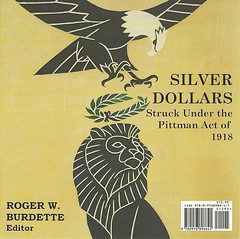 I had a chance this week to take a look at Roger Burdette's new CD-ROM book, Silver Dollars Struck Under the Pittman Act of 1918. Like his previous work on Assay Commission records, this is an electronic-only publication. Where the Assay Commission book was comprised of four DVDs, this slimmer volume fits on a single disc. The packaging is professionally done with a printed color cover with notes in a standard plastic jewel case.
I had a chance this week to take a look at Roger Burdette's new CD-ROM book, Silver Dollars Struck Under the Pittman Act of 1918. Like his previous work on Assay Commission records, this is an electronic-only publication. Where the Assay Commission book was comprised of four DVDs, this slimmer volume fits on a single disc. The packaging is professionally done with a printed color cover with notes in a standard plastic jewel case.
In his Introduction, Burdette notes that:
This digital information storage device includes photographic images of the Treasurer‘s journal of silver dollars produced using silver purchased under authority of the Pittman Silver Purchase Act of 1918. Original documents are located in the National Archives and Records Administration facilities in College Park, Maryland, and Philadelphia, Pennsylvania.
The author's purpose was to make available to researchers and other interested parties original documentary information that would otherwise only be available by traveling to the NARA facilities.
Burdette opens the book with a new nine-page essay titled "The Pittman Silver Purchase Act 1918". Here are a couple excerpts.
Huge subsidies created by the Bland-Allison Act of 1878 and the Sherman Silver Purchase Act of 1890 led to production of millions of largely unwanted silver dollars. The Sherman Act was also a direct contributor to economic depression by requiring purchase of 4,500,000 ounces of silver bullion per month with payment made in notes redeemable in either gold or silver.
This created ideal conditions for speculators who soon threatened the Treasury's gold reserves. Mine owners and speculators grew rich, but the country as a whole suffered. Passage of the Gold Standard Act in 1900, and the return to prosperity following the Panic of 1893 shattered the influence of western silver-state Senators. It took events in remote India to temporarily resurrect silver production in the United States.
The only immediate source of silver was in United States Mint vaults – 490 million silver dollars.
I was completely unaware of the Indian connection. It's a fascinating backdrop to the legislation. The events make for interesting reading.
The mint's silver dollars barely circulated as money. Most were held as backing for silver certificates. While the coins could provide the British with all the silver they needed, only Congress had the authority to permit them to be melted.
In January 1918, it appears that Pittman and Baker began planting exploratory information with newspapers about the need to melt some of the nation's silver dollars.
Senator Pittman and director Baker were given complete responsibility for the emergency silver legislation and conferred with other silver producing state senators and representatives. All were clearly motivated by patriotism and their desire to help the war effort, but they also saw an opportunity to aid mining in their home states.
Mint Director Baker and Assistant Treasury Secretary Leffingwell did not wait for Congress to act. During March and early April, silver dollars were consolidated at the Philadelphia Mint. Unusually large quantities of silver bars were also shipped to India with no public announcement. It is also likely that the breakup and rolling of dollars began well before the Pittman Act was signed. On April 30, 29,745,651 silver dollars were reported demonetized – meaning they were melted or rolled out. Approximately 26 million of these came from the New York Federal Reserve Bank vaults, and were taken to the New York Assay Office for melting.
Initially, this "Pittman silver" as it was commonly called, was used for subsidiary coin production. However, near the end of the year it became evident that economic demand for coins was declining, and a way had to be found to use the silver while minimizing storage costs. The silver was paid for by issuing government certificates (bonds) bearing interest at 2% per year.
Eventually, this domestic silver produced 86,730,000 1921-dated Morgan dollars and 183,502,722 Peace dollars (from 1921 to 1928). This exactly matched the quantity melted during 1918-1919.
I'll stop there with the quotes, but the essay goes on to discuss George Morgan's efforts to produce dies for the new coins. Even though most of the coins went "directly from coinage press to storage vault", Burdette notes that "Artists and coin collectors saw the resumption of silver dollar production as an opportunity to create a new design" which ultimately resulted in the creation of the Peace Dollar.
So THAT'S where those anachronistic 1921 Morgans came from. Burdette's essay is great background reading for any U.S. numismatist, providing insight into not only the reasons for minting these coins, but also why & how so many others were destroyed (and that goes for Silver Certificates, which were also both destroyed and created as an indirect result of the Act).
As for the raw Treasurer‘s journal entries, they provide detailed first-hand evidence of the daily dollar coining activities at the various Mints. Interesting for those who know what they're looking at and what they're looking for. Others may have a harder time extracting value.
But as Burdette noted in the press release for the book,
... only a handful of researchers have ever examined these important records since their re-discovery four years ago. Now collectors and silver dollars specialists can examine documents that were completely unknown to van Allen and Mallis, Breen, Taxay, Bowers and others.
This is the first and only published edition of these invaluable historic resources.

As a bonus, the full text of the Pittman Act of 1918 is included along with a Federal Reserve Bank discussion of silver purchases since the Bland-Allison Act of 1878.
In summary, although the subject matter may not be everyone's cup of tea, this CD-ROM book is a trove of data for any collector or researcher interested in this curious era of U.S. Numismatics.
Silver Dollars Struck Under the Pittman Act of 1918 is available for an introductory price of $8.95 (regularly $12.95) postpaid from the publisher, Seneca Mill Press LLC. Discount orders accepted until February 22.
To order send check or money order for $8.95 to: Seneca Mill Press LLC, PO Box 1423, Great Falls, VA 22066.
BOOK REVIEW: THE TRUE HARD TIMES TOKENS BY ROBERT SCHUMAN
Many thanks to George Fuld and Joe Levine for alerting me to a new book on Hard Times Tokens. I got in touch with the author, Bob Schuman. He kindly sent me a review copy and put me in touch with his publisher.Chris McCawley M & G Publications writes:
We have just published The True Hard Times Tokens by Robert A. Schuman, M.D. The book is 142 pages long, fully illustrated in color and includes a helpful price guide. This first book covers only the political tokens.
The retail price is $90, But E-Sylum readers can obtain a copy for $65 postage paid by writing : M & G Publications, P.O. Box 5250, Frisco, TX, 75034.
 The book arrived Friday and I can tell Bob's a book lover - it was packed as well as I've ever seen a book packed for shipping - wrapped in padding and inside a large, sturdy box padded with packing peanuts. Not a corner was bumped - thanks! It's bound in a nice brown cloth with gold lettering. The paper is thick and glossy, an ideal base for the gorgeous full-color photos throughout.
The book arrived Friday and I can tell Bob's a book lover - it was packed as well as I've ever seen a book packed for shipping - wrapped in padding and inside a large, sturdy box padded with packing peanuts. Not a corner was bumped - thanks! It's bound in a nice brown cloth with gold lettering. The paper is thick and glossy, an ideal base for the gorgeous full-color photos throughout.
Most of us (in the U.S., at least) are somewhat familiar with tokens from the early 1800s called Hard Times Tokens. But what are "True Hard Times Tokens"? Schuman explains in the book's introductory material:
Lyman H. Low, in his magnum opus, HARD TIMES TOKENS, 1900, describes five categories of tokens, which represented his criteria for inclusion into the series. They were:
1. Those having reference to the controversy about the United States Bank.
2. Those bearing popular satirical and political maxims of the period.
3. Those with devices and inscriptions imitating more or less closely the legal coinage.
4. Shop cards, dated, of the period.
5. Mulings with either the obverses or reverses of any of the foregoing.
Categories 1, 2 and 3 are generally referred to as the political series, although many collectors of the Lyman Low era, and even later proponents of the series such as Wayte Raymond and John J. Ford, Jr. considered these to be the so-called true "Hard Times" Tokens. Wayte Raymond, in his STANDARD CATALOGUES of 1940-1942, called the political series - "HARD TIMES TOKENS" and devoted ten pages to them with photographs, prices, and a brief essay by Alfred Z. Reed. The remaining pieces he called EARLY MERCHANT TOKENS 1789-1850 – depicted by photographs and line drawings over 36 additional pages.
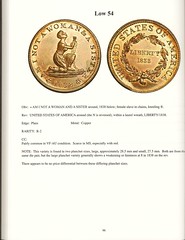 These so-called "Hard Times" tokens are distinct from the merchant
tokens (store cards) issued during the Hard Times era, which have no direct political reference or neutral specie (see Neutral Specie Substitutes discussed later) motif. The store cards need and will receive a serious and studied treatment in separate subsequent works. Those merchant tokens that are directly muled with or mated with actual dies that are a part of the political series (Low's category number 5) will also be included here because of their direct connection to the political pieces and to allow for total inclusion of all political die usage.
These so-called "Hard Times" tokens are distinct from the merchant
tokens (store cards) issued during the Hard Times era, which have no direct political reference or neutral specie (see Neutral Specie Substitutes discussed later) motif. The store cards need and will receive a serious and studied treatment in separate subsequent works. Those merchant tokens that are directly muled with or mated with actual dies that are a part of the political series (Low's category number 5) will also be included here because of their direct connection to the political pieces and to allow for total inclusion of all political die usage.
The purpose of this monograph is to photographically illustrate the tokens described above, and to establish current factual information on rarity, prices realized (both public and private), condition census data where relevant, and die states. Each piece will be described using the original Low numbering system. Anecdotal points of interest will be noted where appropriate, and an effort will be made to correct prior errors or misconceptions if necessary.
We'll look forward to Schuman's subsequent books in the series. The present volume is a welcome work, building on earlier researchers (including Low, Carl Wurzbach, Wayte Raymond, John J. Ford, Jr, and Russ Rulau) and summarizing in one neat volume the current state of knowledge on the topic.
Each major token variety is given a separate page or more, starting with an enlarged color photo of one of the best known specimens. The photos are marvelous, and worth the price of the book alone. For each token the author describes the obverse, reverse and edge, along with the metal, rarity, and condition census - a description of the highest-known condition pieces.
For the rarest tokens a list of known specimens is included, and for many of the tokens there are notes ranging from a short phrase to several paragraphs. Here's something I didn't know: On Low 44 "The H stands for engraver Edward Hulseman."
The book includes a handy price guide in four grades (VF/EF/AU/UNC) plus a table of auction results from the 2004 Ford sale and 2008 Dice-Hicks sale. The Bibliography lists some 15 books, articles and runs of auction catalogs consulted, including unpublished notes and page proofs by John Ford for Raymond's Standard Catalog of U.S. Coins and Tokens (circa 1960).
There's a limited amount of text in the main body book, but what's there is well written and seems pretty thoroughly researched. The white space makes for a very pleasant and usable page layout. The seven pages of introductory material covers a lot of ground, including a treatment of the Bushnell tokens. All in all, this is a welcome new monograph on an interesting topic that has fascinated U.S. numismatists for over a century, and it provides a great baseline of information for the collectors of today and tomorrow.
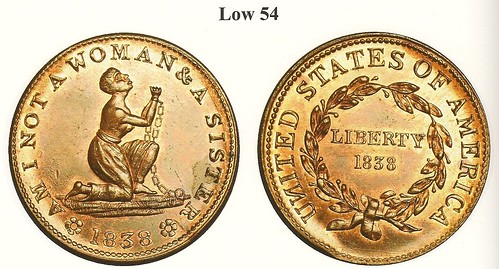
BOOK REVIEW: A GUIDE BOOK OF UNITED STATES PAPER MONEY, 3RD EDITION
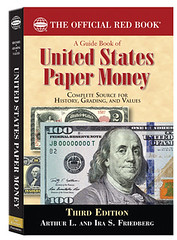 A Guide Book of United States Paper Money, "The Official Red Book," Third Edition, 2011,
A Guide Book of United States Paper Money, "The Official Red Book," Third Edition, 2011,
Authors: Arthur L. and Ira S. Friedberg,
Introduction by
David L. Ganz, Published by Whitman Publishing, LLC,
Reviewed by John & Nancy Wilson
This Third Edition of, "A Guide Book of United States Paper Money," by Arthur and Ira Friedberg has many improvements from the last Edition which was published by Whitman in 2008. This Third Edition has 446 pages, is well illustrated, and has many full-color plates (face and back) of every issue of U. S. paper money from 1861 to present. The color plates are beautifully done and would be hard to improve on in future editions. The book covers market values in grades (with some exceptions) from Very Good to Uncirculated 63. The quantities of notes printed will also be very useful.
Arthur and Ira Friedberg have been involved in U. S. paper money for over three decades. Robert Friedberg (1912-1963) was the author of the 1953 edition of U.S. Paper Money, which became the standard reference at that time. Today, that reference is in its 19th Edition (2010) and published by the Coin and Currency Institute, Inc.
The Friedbergs have brought their vast experience and knowledge from that publication to Whitman for the publication of this standard reference. We particularly liked the comments in the Introduction by Attorney David L. Ganz, a past ANA President and former Mayor of Fair Lawn, New Jersey. Quoting him, "Encyclopedic in scope, it is lushly illustrated and filled with accurate valuations, and it contains the essential Friedberg numbering system that measures your collection's completeness and facilitates cataloging."
The two full pages following the introduction, discuss the $2 bill. This information will be all you need to know about this denomination. The "Civil War Years," will explain the rationale used for the issuance of paper money starting in 1861. The Bureau of Engraving and Printing (BEP) following, along with "The Buck Starts Here," explains in an easy to read manner the formation of this government bureau, and its operation which handles all of our paper money and other fiscal documents. Signs reading, "The buck starts here, printed in green, are attached to each of the four machines that print between 8,000 and 10,000 sheets each hour containing the engraved portions of dollar bills at the multimillion-dollar Western Currency Factory of the BEP." The "World at our Fingertips," explains how paper money is used worldwide and how it dates back to the 9th Century A D. in China.
The "Bank of the United States" gives information on this famous bank which opened in 1791 and went out of business in the late 1830's. Following are sections on, "How to Collect United States Paper Money," and "Grading U. S. Currency," which we feel is a very important section especially if you are a newcomer.
One way we have found to collect U. S. paper money is by denomination. We have a type deuce collection which we have exhibited in the past. A less costly way is to collect Aces or all the $1 denomination notes issued between 1862 – 1923.
The "Storage and Care of Paper Money," will give you information needed for the preservation of the notes in your collection. Notes should be stored in a safe environment (away from sun, heat or dampness), as well as a proper holder, such as acetate or Mylar. Too many notes have been damaged because of improper storage and the use of poly vinyl holders.
The next section covers the "Types of U. S. Currency." They are listed in the order of first passage of the legislation authorizing them. In order of appearance they are: Interest Bearing Notes, Demand Notes of 1861, Legal Tender or U. S. Notes, National Bank Notes, Gold Certificates, Compound Interest Bearing Notes, National Gold Bank Notes, Silver Certificates, Refunding Certificates, Treasury or Coin Notes, Federal Reserve Bank Notes and Federal Reserve Notes.
"Small-Size Currency" follows and they came into circulation on July 10, 1929. Issued were, Small-Size National Bank Notes, Legal Tender Notes, Gold Certificates, Silver Certificates, Federal Reserve Bank Notes, Federal Reserve Notes and Notes Issued For Use During World War ll. Following that is a short paragraph regarding Star Notes, followed by Fractional Currency.
The catalog has all the notes of all the various issues listed by denomination(s) from $1 up to the $10,000. Though the reference covers very thoroughly all the denominations up to the $10,000, page 344 mentions the special $100,000 Gold Certificates Series of 1934 (small size), of which 42,000 were printed. They were issued to facilitate internal transactions with the government and all but a few were redeemed.
U. S. Postage and Fractional Currency (1863-1876) follows and covers all five issues of denominations from 3 cents to 50 cents. Fractional Currency shields are mentioned and the three types are listed with prices. Specimen notes are not covered in this reference and the Friedbergs refer you to their book on U. S. Paper Money. We consider U. S Postage and Fractional Currency, the most undervalued of all numismatic paper money.
Seven pages of the Treasury Notes of the War of 1812 follow and we appreciate the upgraded prices of this rare series. Not listed in the reference is a $3 remainder sheet of four notes which was part of the Ford holdings. This sheet resides in our collection and should be part of the census listed in this book.
The ten pages of Encased Postage Stamps cover the subject very thoroughly. The color plates are wonderfully done, like all illustrations in this catalog. The Error Note section will give you the basic information needed if your interest lies in that area.
Appendix A contains the Signatures of United States Currency and it is always interesting to see how long these officials served. Of great importance is Appendix B, which contains the Friedberg numbers by page. Appendix C contains the Modern Uncut Sheets of U. S. Currency offered by the BEP. The Glossary contains definitions such as Poker Chip Note – Nickname for the Series of 1923 Legal Tender $10 Note. The $10 Denomination, given twice on the back, is surrounded by a round frame (thus the name Poker Chip Note). The bibliography finishes out this wonderful reference.
We think the most beautiful paper money ever issued by anyone in the history of the world are the 13 different issues of large sized or saddle blanket notes that were issued between 1861 and 1923. One reason for the many different changes to our currency between those years was the rampant problem with counterfeiting. A new issue made its appearance and it was quickly counterfeited. This is the same reason for the five different issues of U. S. Postage and Fractional Currency. As soon as an issue made its appearance it was quickly counterfeited.
Quoting the back cover of the book, "Immerse yourself in the romance and beauty of nearly 150 years of American currency." We don't think any country has ever produced a finer currency then the United States. We highly recommend this reference and it will be the only one you will ever need if you are a dealer, collector, beginner, historian or researcher. For more information on this reference which sells retail for $24.95 you can contact the publisher at: Whitman Publishing, LLC, 3101 Clairmont Road, Suite G, Atlanta, GA 30329, Phone (404) 235-5300 or fax to (404) 235-5350 or visit the Whitman web page at: http:/www.whitmanbooks.com
MODERN COIN COLLECTORS: YOUR TIME IS NOW
WILLIAM L. BISCHOFF 1938 - 2010
Richard Doty writes:
William Bischoff, my successor as Curator of Modern Coins and Paper Money at the ANS, later Curator of Numismatics at the Newark Museum, also passed away, right before Christmas. Bill was an engaging, funny man with new and worthwhile takes on Numismatics, and he'll be greatly missed by all who knew him.
Robert Hoge was a close friend of Bischoff's, and he's writing an obituary for ANS Magazine. He writes:
Bill died December 22, 2010. I announced his passing at the January meeting of the New York Numismatic Club on January 14th. Bill's niece has informed me that there will be a memorial service in honor of Bill, probably some time in March.
Richard Doty adds:
Bill saw the connectedness between Numismatics, world history, the big picture. There are splitters in this world, and there are lumpers. Splitters research more and more about less and less. Lumpers see the whole thing, all of human development and potential, in all its messy glory. Bill was a lumper. (So am I. That's why we got along so well.)
ALAN STAHL RECEIVES ROYAL NUMISMATIC SOCIETY MEDAL
Alan Stahl, Princeton University's Curator of Numismatics, has received the Medal of the Royal Numismatic Society for 2010. The Society's Medal is awarded annually to "some person highly distinguished for services to Numismatic Science." It was presented to Stahl on January 18, 2011, at a meeting held at the Warburg Institute in London, by Society President Nicholas Mayhew, Director of the Winton Institute for Monetary History, Oxford University.

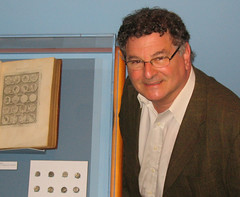
In his citation, Mayhew characterized Stahl's book Zecca: The Mint of Venice in the Middle Ages as 'magisterial' and added that "there can be few areas of historical research where the efforts of one scholar have borne such rich and significant historical, numismatic and economic fruit." He continued, "Yet although Stahl remains for most us ‘Mr Venice', the range of his work over his academic life is much greater than that. His earliest numismatic focus was on Merovingian France, and his publications in that area remain the most up to date and comprehensive works in that field." Mayhew went on to acknowledge Stahl's contributions to the study of the medal and to numismatic history and methodology, as well as his decades of teaching numismatics as an academic discipline.
In accepting the medal, Stahl said that "My relationship with numismatics has produced benefits that derive more from the people I have encountered through it than from the coins I have studied," and recounted his gratitude to mentors at the University of Pennsylvania, former colleagues and students at the American Numismatic Society and current ones at Princeton, as well as to the members of the "small and close-knit world of numismatic scholars." He then delivered a formal address entitled "Learning from the Zecca: The Medieval Mint of Venice as a Model for Pre-modern Minting."
Stahl is the ninth American to receive the Royal Numismatic Society Medal since it was instituted in 1883. The current version of the award is a 4-inch cast silver medal commissioned from the British sculptor Ian Rank-Broadley in 1993. The obverse depicts Hercules and the Lion, a common numismatic subject. On the reverse, the inscription reads OPTIME MERENTI (to the most deserving) PRAEMIVM SOCIETATIS REGIAE NUMISMATICAE (the prize of the Royal Numismatic Society). The recipient's name is engraved on the edge.
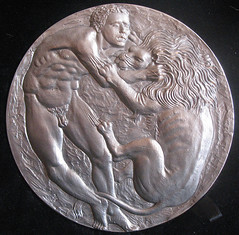

AMERICAN NUMISMATIC SOCIETY ARCHIVES UPDATE
I'm the archivist at the American Numismatic Society. A little over a year ago you were kind enough to publish in E-Sylum (v.12, no. 40, 10/4/2009 ) information that my predecessor, Joe Ciccone, had sent regarding brief descriptions of archival collections on our website.
I'm happy to say that we have been building on the great work that Joe accomplished, and we now have detailed biographical and content descriptions available online for most of the collections of personal papers.
In addition, the collections have been fully cataloged in ANS's new library catalog DONUM, which is open and available to anyone.
To access the ANS Archives, see: www.numismatics.org/Archives/Collections
To access DONUM, see: donum.numismatics.org
To read the earlier E-Sylum article, see: AMERICAN NUMISMATIC SOCIETY ARCHIVAL COLLECTIONS (www.coinbooks.org/esylum_v12n40a10.html)
NEW ORLEANS MINT RECORDS AT FORT WORTH NATIONAL ARCHIVES
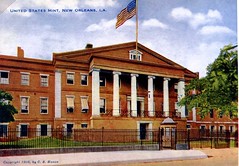 It may come as a surprise to many readers, as it did to our cataloging staff, to learn that some of the New Orleans Mint records are in the National Archives in Fort Worth. Two weeks ago the Heritage cataloging staff (me, John Dale Beety, Dave Stone, and Mark Borckardt) went on a "field trip" and spent the day examining some of the documents of the mint and the later assay office. We were able to examine letters and invoices relating to the repair of the mint building from 1856-1858, a register of gold bullion, coins, and jewelry received from 1850 through 1860, and the record of department letters received from 1897 to 1911.
It may come as a surprise to many readers, as it did to our cataloging staff, to learn that some of the New Orleans Mint records are in the National Archives in Fort Worth. Two weeks ago the Heritage cataloging staff (me, John Dale Beety, Dave Stone, and Mark Borckardt) went on a "field trip" and spent the day examining some of the documents of the mint and the later assay office. We were able to examine letters and invoices relating to the repair of the mint building from 1856-1858, a register of gold bullion, coins, and jewelry received from 1850 through 1860, and the record of department letters received from 1897 to 1911.
No one seems to know why these documents are in Fort Worth or even how long they have been there. One of the Archivists said the mint records had been examined "only a couple of times." In a previous conversation another Archivist said "never." The documents are listed under general categories by going to:
www.archives.gov/research/guide-fed-records/groups/104.html
THE NATIONAL NUMISMATIC MUSEUM OF GREECE

Here's a suggestion for Mr. Berlin: I recently returned from Athens, Greece. While there, I went on a hunt for the mansion that Heinrich von Schliemann built for his beloved Sophia, and to my amazement, upon finding it discovered it was now the national numismatic museum of Greece. So it was truly a tourism homerun for me.
Fabulous displays of ancient Greek and Roman coinage, as well as Byzantine and Medieval European coinage are housed in elegant glass and wood cabinets, conveniently angled for viewing. They are scattered throughout the mansion.
The amazing mosaics that Schliemann ordered made, as well as a few sculptures brought back from Troy and elsewhere are all there to be enjoyed as well. The museum was virtually deserted except for the guards that are posted in each room, mostly young, personable local college students.
I highly recommend carrying along a small flashlight, as some of the rooms are not brightly lit enough, or the lights reflect off the glass top of the cabinets. Photography is forbidden for security reasons.
The museum is in the very heart of Athens, a hop skip and jump away from the first modern Olympic stadium where the runner from Marathon collapsed and died, and from the Temple of Zeus, the Acropolis, and the dungeon where Socrates was forced to drink his hemlock cocktail. I can't wait to return.
To visit the museum web site (in English), see: www.nma.gr/index_en.htm
To read the earlier E-Sylum article, see: SUGGESTIONS FOR THE NUMISMATOURIST: FINLAND AND SERBIA (www.coinbooks.org/esylum_v14n04a14.html)
COULD MORE E-BOOKS REVITALIZE NUMISMATIC HOBBY?
I would like to comment on the following statement from David Lange:
The problem I have with doing a book solely in electronic format is one which many numismatic authors and publishers may have encountered---ours is a hobby that caters mostly to older people. I know that the buyers of my current book and the subscribers to my price lists and newsletters are mostly my age and older.
When I started this thread, I asked for more e-book options and not to replace paper books. I do not expect segments of the population to accept electronic options. However, there is a large segment of the population that not only wants access to e-books but will be lost to the hobby if the e-books are not an option.
My blog is mostly read by people my age (50) and younger. Not only is this the future of the hobby, but it is a segment of the hobby that will thrive with access to e-books. They are the future of the hobby and they are growing up in an electronic world.
I think the hobby is losing a lot of potential members by not having e-book options available to them. Even as a Young Numismatist grows up and enters the transition to young adult, they are armed with computers, e-readers, iPads, and smart phones. They consume electronic media more than paper. In fact, those whose attend college are finding that more of their materials are being made available in electronic form to where some schools are giving away iPads to support this move.
One thing we like about consuming electronic information is that it is less expensive. While the information does cost to produce, electronic information does not have the physical production costs and does have a cheaper distribution mechanism. Although Amazon.com has had significant push-back from publishers over their dictated pricing model, there have been many published reports claiming publishers are still earning profits selling for the Kindle. Many have suggested that publishers are using profits from e-books to offset the lower profits from their paper versions.
In my blogpost, I wrote, "Publishers who have not embraced the e-reader will lose out on the business of younger numismatists and technology-oriented people like myself." If the information was available in electronic format, I wonder if the average age of the hobby will be lowered? I think so.
To read the earlier E-Sylum article, see: DAVID LANGE ON PUBLISHING IN NUMISMATICS (www.coinbooks.org/esylum_v14n04a08.html)
KEN BRESSETT ON ASTROLOGICAL SYMBOLS ON ANCIENT COINS
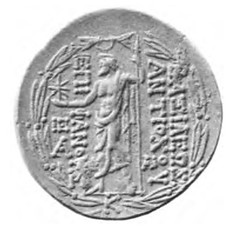 Regarding astrological symbols on ancient coins it must be noted that not all are related to a particular astrological event. The star was often used on both Greek and Roman coins to represent a form of divinity. This seems to have been particularly true of coins minted in Antioch. The particular design described in the article by Professor Weir was used by Antiochus VIII on many of his silver tetradrachs made from 121-113 B.C., and again on some of the similar coins minted during his third reign from 111-109 B.C. The symbol has been identified by E.T. Newell as particular to the standing figure as Zeus Uranus.
Regarding astrological symbols on ancient coins it must be noted that not all are related to a particular astrological event. The star was often used on both Greek and Roman coins to represent a form of divinity. This seems to have been particularly true of coins minted in Antioch. The particular design described in the article by Professor Weir was used by Antiochus VIII on many of his silver tetradrachs made from 121-113 B.C., and again on some of the similar coins minted during his third reign from 111-109 B.C. The symbol has been identified by E.T. Newell as particular to the standing figure as Zeus Uranus.
Other Syrian coins showing such stars include those of Antiochus IV (Second series, 169-167 B.C., Newell #55 and #56); Antiochus VI (144-143 B.C.); and Antiochus IV of Commagne (A.D.38-72). In the case of the tetradrachms and drachms of Antiochus IV two stars are shown adorning the diadem of the king on the obverse to show his divine nature as representative of Zeus on earth.
Tetradrachms of Antiochus VI (Newell #221, minted 144-143 B.C.) have a large star adjacent to the king's head on the obverse, as well as stars over the heads of the dioscuri on the reverse. The stars on these coins are identical in form to the one shown on the example cited by Professor Weir.
To read the earlier E-Sylum article, see: PROFESSOR STUDIES ASTROLOGICAL SYMBOLS ON COIN OF ANTIOCHOS VIII (www.coinbooks.org/esylum_v14n04a21.html)
THE BOOK BAZARRE
PROPOSED NEW TERMS FOR A NUMISMATIC ENCYCLOPEDIA
James Higby writes:
I'd like to see the inclusion of the term bifurcation - the deformation of peripheral lettering due to inadequate availability of metal to fill the die. Most often this shows as a dent at the bottom of the upright part of the letters. It is often seen on early U.S. coins.
Howard A. Daniel III writes:
I am VERY sure Dick Johnson is looking for new terms in English but I could not resist sending one in Vietnamese. After writing my English language description of grading in my Socialist Republic of Viet Nam Coins & Currency catalog, I went to my many Vietnamese dictionaries to find the equivalent of Mint Strike (MS) or condition in Vietnamese. I could not find anything so I contacted several educated Vietnamese and we settled on the new term of Tinh Trang (TT). And it is also good for Print State (PS) for paper money. We are hoping it will show up in the next editions of the dictionaries. We shall see.
Five E-Sylum readers responded to my request last week for terms perhaps they have created, to be included in my upcoming encyclopedia of coin and medal technology. I wish to thank Ken Bressett, James Higby, Ron Abler, Howard Daniel, and Mark Borckardt.
Howard created a term in Vietnamese for MINT STATE and one for use for paper money as well. Then he surmised I wanted English terms only. Both outside the scope of terms I was seeking for diestruck items only, coins and medals.
 Jim Higby submitted a term for the use of certain lettering and we had a fascinating exchange of emails on the subject. He submitted BIFURCATION. It means to double or fork. It accurately describes the lower part of vertical stems on letters in the legends on some early American coins. Later, after he had done some concentrated research, he had tracked the first use of the term in this context back to M.H. Bolender.
Jim Higby submitted a term for the use of certain lettering and we had a fascinating exchange of emails on the subject. He submitted BIFURCATION. It means to double or fork. It accurately describes the lower part of vertical stems on letters in the legends on some early American coins. Later, after he had done some concentrated research, he had tracked the first use of the term in this context back to M.H. Bolender.
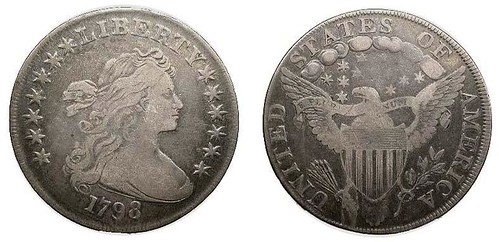
"OK," he wrote, "you forced me into consulting my numismatic library (which I hope one day will house a copy of your forthcoming book!). I correctly remembered that it was Dr. M. H. Bolender who first came up with the term in his seminal work on early dollars, so I checked in the most recent manifestation thereof by the late, great Jules Reiver. Attached are scans of pages 7 and 8 of his The United States Early Silver Dollars 1794 to 1803 that update the Good Doctor's thoughts.
 Jim suggests the inverted Y base of the vertical stems is a result of insufficient metal attempting to fill these letter cavities in the die at the time of striking. There is some support for this. Examine the broken O on the one cent reverse on the adjacent photo -- also lacking a fully-formed letter. I had suggested it was, perhaps, the shape of the letter punch. This may elicit further comments from other knowledgeable E-Sylumites.
Jim suggests the inverted Y base of the vertical stems is a result of insufficient metal attempting to fill these letter cavities in the die at the time of striking. There is some support for this. Examine the broken O on the one cent reverse on the adjacent photo -- also lacking a fully-formed letter. I had suggested it was, perhaps, the shape of the letter punch. This may elicit further comments from other knowledgeable E-Sylumites.
Mark Brockardt wrote "I am looking for a term to describe the Indian Head quarter eagles and half eagles of Bela Lyon Pratt, and they are different from what you have in your entry for SUNKEN RELIEF As I understand the terms, the Pratt designs are not INTAGLIO or INCISED They are not a "NEGATIVE RELIEF," rather a positive relief that is sunk into the surrounding surface (field) of the coin. I am unaware of any other instance where the Pratt technique is used in coinage.
'There has to be some sort of technical term that properly describes the Pratt design. I have often heard people describe these as "INCUSE, a term I consider entirely incorrect.'
I insisted SUNKEN RELIEF was entirely correct. He responded then, "what is raised relief in a sunken panel, does such a term exist?"
Raised relief in a sunken panel DOES have a name. It is called COELANAGLYPTIC RELIEF. All forms of relief in English come from their names in Italian. The Italian name for this is cavo-rilievo. This is the type of relief on ancient Egyptian walls and pyramids, so it is also known as EGYPTIAN HOLLOW RELIEF (which some writers shorten to just "hollow relief").
But in all cases the raised relief in the sunken panel does not exceed the level of the background or field.
I cover six types of relief in my encyclopedia. The type of relief necessary for coin models is VERY LOW RELIEF which most of us simply call COIN RELIEF. Everyone knows it must have no undercutting and must have a slight bevel on the sides of all lettering, devices and images, as every die must strike and withdraw with this relief pressed into the surface of the blank. Yes this type of relief has an Italian name you never heard of: stiacciato.
Artists are far freer in the use of a variety of reliefs on models from which medals are made as they do not have the restrictions of coins which must be struck complete in one blow.
I greatly appreciate my correspondents' comments. And if you have a term that you use and would like to have considered, kindly fire it along. Or perhaps, a numismatic situation in which you would like to know if a term already exists. If you coin a new term, or term a new coin -- write me -- dick.johnson@snet.net
To read the earlier E-Sylum article, see: DICK JOHNSON SEEKS NEW TERMS FOR NUMISMATIC ENCYCLOPEDIA (www.coinbooks.org/esylum_v14n04a06.html)
GUS ZIMMERMAN'S TARGET SHOOTING MEDALS
Katie Jaeger writes:
I stumbled on this while searching the photo collections of the Museum of the City of New York. It is a photo of target shooting champion Gus Zimmerman's collection of medals and trophies, circa 1901. The zoom viewer allows you to examine each item a bit more closely. I count about 70 prize cups, a fabulous clock, a giant silver platter, some kind of rifle tripod thing, four laurel wreaths (one with a target in the center), probably 250+ medals, and just for fun, one Etruscan and one Amazon standing on ornate three-legged bases. Most of them appear to be made of precious metal.
Zowie! I think this would be a fun one to share in The E-Sylum.
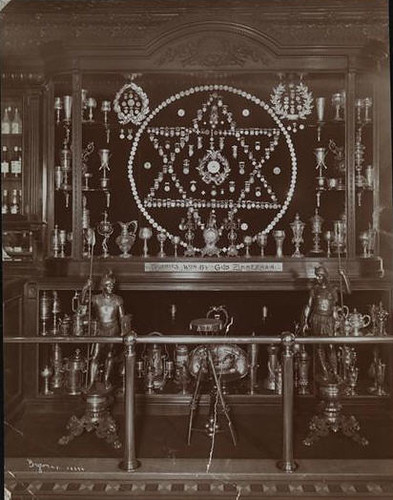
Kay Freeman adds:
The photo was taken March 1896 at Madison Square Garden. He had a display at the 2nd Sportsmen's Week Exposition. "medals ... are all neatly arranged in the shape of a huge star in a cabinet about 12 feet in height and nearly as broad." (NY Times, March 16, 1896)
A March 16, 1896 article says prominently displayed is a wreath won at the recent International Schuetzenfest. That wreath was donated by the New York Times and you can see in the center of the star of medals.
Katie Jaeger adds:
If you can't get there from the link below, just go to the Museum of the City of New York website, click on "Collections Portal," and enter the search term "medal."
To access the photo, see: Gus Zimmerman's collection of medals and trophies, circa 1901
NOTES FROM E-SYLUM READERS: JANUARY 30, 2011
David Fanning asks that all emails to him be addressed to df@numislit.com. He is closing his old email account, and future emails addressed to dfanning@columbus.rr.com may not be delivered. Please make a note of it.
Richard Doty of the Smithsonian writes;
I can only say that Joe Lasser was a great colleague, teacher, and friend. I can't believe he's gone, and I would give anything to have him back with us again. I knew him for thirty-five years. I wish I'd known him longer.
To read the earlier E-Sylum article, see: JOSEPH R. LASSER 1923 - 2011 (www.coinbooks.org/esylum_v14n04a02.html)
Regarding the Daniel Carr Tesla piece, Joe Boling writes:
Nikola Tesla had an intimate connection with Colorado Springs. He established a laboratory there because the region was reputed to have more lightning strikes than anywhere else in the country. Having lived through some of the Summer Seminar thunderstorms, I can easily believe it.
On a related note, a visitor to our Flickr photo archive had this to share:
Tesla spent last ten years and died in Room #3327 because Earthquake Machine No. 3 was the Knob Hill Apparatus in Colorado Springs which caused the 27 day long 1899 Alaskan Earthquakes commencing on September 3, 1899 at 3h03m27s or 3:03:27 pm epicenter time. That was a year divisible by 3 times 3, a month divisible by 3 times 3, a day divisible by 3, in an hour divisible by 3, a minute divisible by 3, a second divisible by 3 times 3 times 3 days and it was Earthquake Milne Shide No. 333 and lasted 3 times 3 times 3 days.
This is from straight the USGS regarding the 1899 earthquakes at Yakutat Bay, Alaska.
To read the earlier E-Sylum article, see: INTERVIEW WITH COIN ARTIST AND DESIGNER DANIEL CARR (www.coinbooks.org/esylum_v14n04a17.html)
Joe Boling also pointed out a mis-spelling in my Numismatic Diary. Oops! I wrote:
"Treasurer of the U.S. Rosa Gurntaotao Rios"
Joe notes that "it's Gumataotao".
To read the earlier E-Sylum article, see: WAYNE'S NUMISMATIC DIARY: JANUARY 23, 2011 (www.coinbooks.org/esylum_v14n04a19.html)

Sharp-eyed Joe also found a whopper in the Carnegie Medal lot description. I should have caught this one myself, since it's pretty glaring. Thanks! We can blame this one on the cataloguer. Joe writes:
"GREATER LOVE HATH DO MAN THAN THIS, THAT A MANY LAY DOWN HIS LIFE FOR HIS FRIEND." There are three typos in that line.
Indeed - it's a quote from the Bible (John 15:13), and the medal inscription actually reads: "GREATER LOVE HATH NO MAN THAN THIS, THAT A MAN LAY DOWN HIS LIFE FOR HIS FRIENDS."
Here is a reference I have never before seen and it might be of interest to one or more E-Sylum readers.
To view the complete lot description, see: ESSAY TOWARDS AN HISTORICAL ACCOUNT OF IRISH COINS AND OF THE CURRENCY OF FOREIGN MONIES IN IRELAND (www.sixbid.com/nav.php?p=viewlot&sid=351&lot=538)
To read the complete lot description at the Gerhard Hirsh web site, see: 1/8 Dollar 1853 California Gold (www.coinhirsch.de/?cat=270-271&lot=4296)
Len Augsburger writes:
This doesn't necessarily have a lot to do with coins, but got me thinking -- there is a lot of recent numismatic history which is surprisingly elusive. Dave Bowers, Tom DeLorey, Dave Lange and others work tirelessly in this area, documenting modern events which might easily escape the historians of the future.
To read the complete article, see:
Stanley Cup-winning puck has been missing since Kane scored
(www.chicagotribune.com/news/local/ct-met-missing
-stanley-cup-puck-20110128,0,6346756.story)
THE BOOK BAZARRE
MARCEL DUCHAMP'S MONTE CARLO BOND NO 1
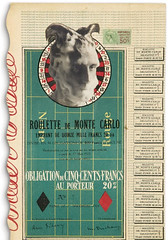 In 1924 Duchamp devised a system of wagering in roulette, whereby his experiments with the laws of chance might be profitably applied to the gambling tables of Monte Carlo. It appears that he first tried to work out the details of this system with the help of his friend and Dada co-conspirator Francis Picabia.
In 1924 Duchamp devised a system of wagering in roulette, whereby his experiments with the laws of chance might be profitably applied to the gambling tables of Monte Carlo. It appears that he first tried to work out the details of this system with the help of his friend and Dada co-conspirator Francis Picabia.
Duchamp decided to expand upon its principles and profits by simply increasing the amounts of money wagered. In order to raise the funds required to finance a more ambitiously conceived operation, he planned to issue stocks in his new company - thirty shares at an assigned value of 500 francs each - repayable to investors at the rate of 20 interest over the course of a three-year period.
Ownership in the company would be established by the purchase of a bond, a legal document that Duchamp himself carefully designed and issued. The bond features a diagrammatic, overhead view of a roulette table, crowned at the summit by a photo-collaged portrait of Duchamp by Man Ray. Duchamp's features in this photograph are barely discernable; his head is completely enveloped in layers of shaving lather, his hair peaked into two devilish horns, intended, perhaps, as a commentary on the diabolic nature of his enterprise.
As these various items were designed with humorous intent, there is little doubt that Monte Carlo Bond was intended to elicit a like response, although we now know that - for Duchamp and his potential investors - it was also to be understood as a bona fide legal document. Once he had determined the final appearance of the bond, he arranged for it to be printed and made available for purchase.
Years after his gambling scheme failed, Duchamp admitted to an interviewer that the gambling scheme he devised was ineffective: he won nothing (quoted in Salt Seller, p. 137). "The system was too slow to have any practical value," he told an audience a few years before his death, "sometimes having to wait a half hour for the propitious figure to appear in the succession of blacks and reds. And the few weeks I spent in Monte Carlo were so boring that I soon gave up, fortunately breaking even"
To view the lot description, see:
Monte Carlo Bond (No. 1)
(www.christies.com/LotFinder/lot_details.aspx?
from=salesummary&intObjectID=5371694&sid=83613912-
9be9-404a-a3a9-2124bb9d011d)
HISTORIAN ACCUSED OF ALTERING LINCOLN DOCUMENT AT NATIONAL ARCHIVES
Archivist of the United States David S. Ferriero announced today that Thomas Lowry, a long-time Lincoln researcher from Woodbridge, VA, confessed on January 12, 2011, to altering an Abraham Lincoln Presidential pardon that is part of the permanent records of the U.S. National Archives. The pardon was for Patrick Murphy, a Civil War soldier in the Union Army who was court-martialed for desertion.
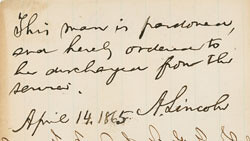
Lowry admitted to changing the date of Murphy's pardon, written in Lincoln's hand, from April 14, 1864, to April 14, 1865, the day John Wilkes Booth assassinated Lincoln at Ford's Theatre in Washington, DC. Having changed the year from 1864 to 1865, Lowry was then able to claim that this pardon was of significant historical relevance because it could be considered one of, if not the final official act by President Lincoln before his assassination.
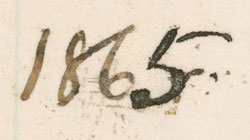 National Archives archivist Trevor Plante reported to the National Archives Office of Inspector General that he believed the date on the Murphy pardon had been altered: the "5" looked like a darker shade of ink than the rest of the date and it appeared that there might have been another number under the "5". Investigative Archivist Mitchell Yockelson of the Inspector General's Archival Recovery Team (ART) confirmed Plante's suspicions.
National Archives archivist Trevor Plante reported to the National Archives Office of Inspector General that he believed the date on the Murphy pardon had been altered: the "5" looked like a darker shade of ink than the rest of the date and it appeared that there might have been another number under the "5". Investigative Archivist Mitchell Yockelson of the Inspector General's Archival Recovery Team (ART) confirmed Plante's suspicions.
This matter was referred to the Department of Justice for criminal prosecution; however the Department of Justice informed the National Archives that the statute of limitations had expired, and therefore Lowry could not be prosecuted. The National Archives, however, has permanently banned him from all of its facilities and research rooms.
At a later date, National Archives conservators will examine the document to determine whether the original date of 1864 can be restored by removing the "5".
To read the complete press release, see: National Archives Discovers Date Change on Lincoln Record (www.archives.gov/press/press-releases/2011/nr11-57.html)
The Archives on Monday accused Lowry of altering the pardon in plain view in the agency's main research room to amplify its historical significance. Lincoln had indeed issued a pardon to Pvt. Patrick Murphy, but the 16th president did it exactly one year to the day before he was assassinated by John Wilkes Booth. Archives officials, after a year-long investigation, say Lowry signed a written confession Jan. 12 that he brought a fountain pen into the research room sometime in 1998 and wrote a 5 over the 4 in 1864, using a fade-proof ink.
Lowry, a retired psychiatrist who discovered the pardon in an unsorted file box, has denied any wrongdoing. He said he was pressured by federal agents to confess.
"I consider these records sacred," he said in an interview Monday at his Woodbridge home. "It is entirely out of character for me. I'm a man of honor."
His wife, Beverly, said the change was made by a former Archives staffer, a charge the agency denies.
"He became known as somebody who found an amazing document," Brachfeld said. "You take a figure like Lincoln, you say he signed this on the day he died and amplify it, and it became one of our more important documents."
The Archives does not inventory its holdings because they are so vast, so the Lowrys' discovery "had huge implications," Plante said Monday. "The story of this pardon has been told over and over for the past 13 years. It's everywhere in Civil War history."
With each passing viewing, he grew more suspicious that something wasn't right. The ink on the "5" in 1865 always looked too dark, and it appeared to him that another number was written under it.
"It was one of those gut feelings you get," Plante said. "Something wasn't right."
His suspicions were confirmed when he consulted a respected collection of Lincoln's writings edited by Roy P. Basler in the 1950s. Basler reprinted the pardon of Murphy with the date April 14, 1864. "In the 1950s, that was the date, so at some point it changed," Plante said.
Lowry said he was in his bathrobe shaving when he heard a knock on his door on the morning of Jan. 12. It was two agents with the Archives.
Lowry recalled sitting at his dining room table with the men and repeatedly telling them that he never changed the pardon. Eventually, however, investigators said Lowry confessed to making the alteration and offered details.
The pardon will be removed this week from an evidence room at the inspector general's office and brought to the Archives' preservation labs, where experts will try to restore the original date. Plante says he's not optimistic, though, since "Lowry purposely used ink that's going to last a very long time."
"It makes me very angry," Plante said. "We have a level of trust with researchers, and that trust was broken."
To read the complete article, see: http://www.washingtonpost.com/wp-dyn/content/article/2011/01/24/AR2011012404713.html (www.washingtonpost.com/wp-dyn/content/article/2011/01/24/AR2011012404713.html)
9/11 MUSEUM TO DISPLAY "HOLOCAUST COIN"
A rare $20 Gold St. Gauden's coin, one of 200 sewn into a leather jacket by a Jewish family and smuggled out of European territory that was about to be occupied by the oncoming Nazis in 1940 has been gifted to the Ground Zero Museum Workshop in New York City by prominent rare coin dealer John Albanese and will be on display starting in February, 2011, says Museum Founder Gary Marlon Suson.
The 200 coins, now labeled and graded as the "World War 2 Exile Hoard" by Numismatic Grading Services (NGC) in Florida, were purchased in Europe last month with their unusual history being revealed to the French buyer. During the turbulent period just prior to World War II, these coins were withdrawn from the bank by a Jewish family and were a trove meant to sustain them through the worst possible situation.
Just subsequent to the Nazi invasion of this family's home country in 1940, each of the coins was sewn into the lining of a leather coat by the family. With great risk, they were spirited out to a safe-haven neutral country, where they have been kept ever since. According to the gold buyer, who relayed the history of these coins to NGC, the family in possession of the coins elected to sell them this year because gold had risen to record price levels. The group of 200 coins have all been individually encapsulated by NGC with the pedigree WWII EXILE HOARD.
Ground Zero Museum Workshop, the tiny 9/11 Nonprofit Museum in NYC's Meatpacking District and currently on ‘Trip Advisor's Top 12 NYC Attractions List' – was founded by Gary Marlon Suson, an FDNY Honorary Battalion Chief who served at the World Trade Center as "Official Photographer at Ground Zero" for the NYC Fire Unions under the supervision of Manhattan Trustee Rudy Sanfilippo and FDNY Chief of Department Daniel Nigro.
Suson's visit in 2004 to the Anne Frank House in Holland left him amazed at how such a miniscule museum could have such a profound impact. He was then inspired to create a similar Museum in NYC so visitors could learn about the 9/11 "Recovery Period." The Museum, which features 100 Images & Artifacts from WTC and raises funds for 9/11 charities has since developed a cult-like following and is regularly featured on Top 10 Lists. On display at the Museum is Anne Frank's book and ironically, one of Anne Frank's last surviving relatives visited GZMW in 2006.
One past visitor to GZMW, rare coin expert John Albanese, the CEO of Certified Acceptance Corporation (CAC) in Bedminster, New Jersey, became a fan of the Museum and Suson's collection of images and remembered that the Museum's inspiration came from the Anne Frank House. Just weeks ago, Mr. Albanese bought the hoard of coins from the French dealer and decided to gift the very first of the two hundred WW2 EXILE Coins to the Museum.
"I thought it would be a fitting artifact to donate to the Museum since both 9/11 and the Holocaust have to do with oppressive and violent acts towards the innocent, so we contacted Gary and he was very touched by the gesture. His Museum was inspired by Anne Frank House, so I saw the connection." The Museum is building a special case to house the coin, valued in the many thousands of dollars. Says Suson, "We are honored with this gift and think the coin will only add to our already poignant displays. While our Museum focuses on 9/11 and the "Recovery" – I think it will be nice to have this coin on display for our guests, as it represents the spirit of overcoming adversity under turbulent times. The history of the coin and its long, 70-year road to our Museum is truly remarkable."
While other US gold coins, in particular St. Gaudens, come from caches with other unique histories, several features contribute to the significance of this "Exile" group. When the coins arrived at NGC in Florida, many of them had bits of leather still adhering to the coins' rims. At the request of the French dealer, professionals at Numismatic Conservation Services expertly removed the leather so that the coins would be eligible for certification. Their unconventional storage in the leather coat imparted a number of the coins with a delicate reddish patina that was left untouched during conservation.
Another unusual feature is the uniformly high grade of these coins. Each graded from MS 63 to MS 67, with seven coins achieving this highest grade and a greater number grading each MS 66 and MS 66+. All are dated 1924 and 1925, with over three-quarters being from the latter date.
Ground Zero Museum Workshop can be contacted atGroundZeroMuseum@gmail.com. To purchase tickets to GZMW's daily 2-hour tours, call ZERVE at 212-209-3370. (Press Inquiries: Call Museum Direct: 212-924-1040).
To read the complete press release, see: 9/11 Museum to Display Rare Holocaust Coin (www.ibtimes.com/prnews/20110126/9-11-museum-to-display-rare-holocaust-coin.htm#)
LAWMAKERS ATTACK NATIONAL COLLECTOR'S MINT LATEST 9/11 "COINS"
 Sen. Chuck Schumer and Rep. Jerrold Nadler have it right: The Federal Trade Commission must do all in its power to stop the exploitative hucksters at the National Collector's Mint from shamelessly trafficking in the memory of 9/11.
Sen. Chuck Schumer and Rep. Jerrold Nadler have it right: The Federal Trade Commission must do all in its power to stop the exploitative hucksters at the National Collector's Mint from shamelessly trafficking in the memory of 9/11.
As spotlighted on this page three weeks ago, the company is hawking a wholly bogus, almost worthless geegaw through blatantly deceptive TV ads. The spots are designed to convince viewers - falsely - that they have the opportunity to buy a government-sanctioned coin produced to mark the 10th anniversary of the terrorist attacks.
And not only that, but a coin sheathed in silver mysteriously and unverifiably recovered from a vault below Ground Zero.
The price is $29.95 for a trinket whose true value has been estimated as low as 2 cents and as high as 60 cents.
In 2004, the outfit peddled a Freedom Tower Silver Dollar as "legally authorized government issue" from the Northern Mariana Islands. Charging fraud, then-state Attorney General Eliot Spitzer won $2 million in refunds and cancellations, and $369,000 in penalties.
In 2006, the mint resurfaced with a Fifth Anniversary World Trade Center Commemorative Coin that was equally reprehensible. And now it's back with a fresh scam in year 10.
The FTC must come down as hard and swiftly as the law allows. The object must be to halt further sales. They are a desecration and, compounding the insult, they will surely divert money from the U.S. Mint's plan to sell official 10th anniversary medals in a fund-raising campaign for the World Trade Center Memorial Foundation.
These creeps must be stopped.
To read the complete article, see:
FTC should come down hard on sleazy National Collector's Mint and its bogus 9/11 medals
(www.nydailynews.com/opinions/2011/01/27/
2011-01-27_stamp_out_the_coin.html)
FEATURED WEB PAGE: COPPIN'S 1858 BALLOON MEDAL
This week's Featured Web Page is about Coppin's Balloon medal of 1858, from the Museum Victoria Australia web site.

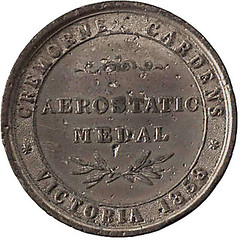
This is a commemorative medal thought to have been sold as a memento to people who viewed the public ascent of George Coppin's balloon from the Cremorne Gardens. Coppin had purchased his balloon on a visit to England and hired two "daring Aeronauts", Dean and Brown, to make tethered flights three times a week.
museumvictoria.com.au/coins/1851/
coppins_baloon_medal.html

